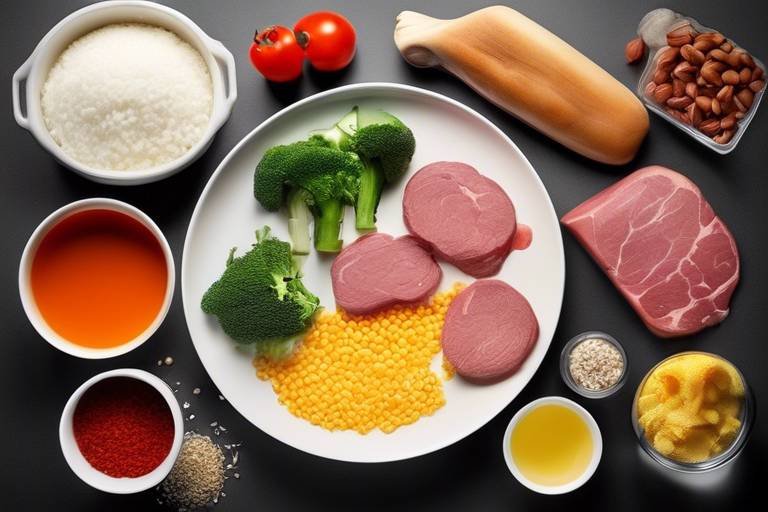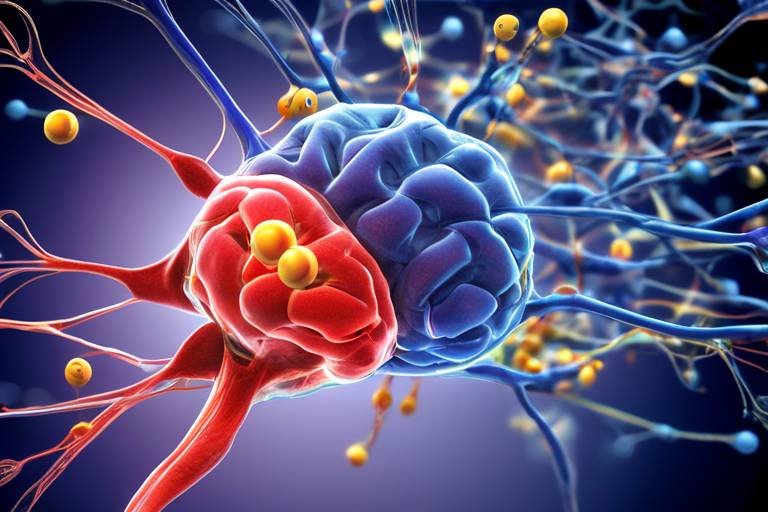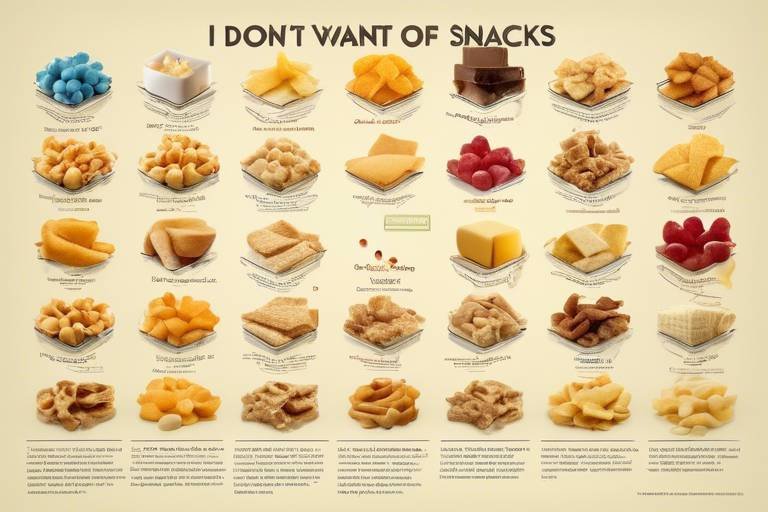The Chemistry of Healthy Fats - Choosing Wisely
In today's fast-paced world, where convenience often trumps nutrition, the importance of healthy fats in our diet cannot be overstated. With a plethora of information available, it can be overwhelming to decipher what constitutes a healthy fat. This article aims to demystify the chemistry behind healthy fats, their vital roles in our body, and how to make informed choices that can lead to better health. Imagine your body as a finely-tuned machine; without the right fuel, it simply won't run efficiently. Healthy fats are that essential fuel, providing not only energy but also supporting various bodily functions.
Fats are often misunderstood and unfairly demonized in the realm of nutrition. However, they play a crucial role in our overall health. Fats are a concentrated source of energy, providing 9 calories per gram, which is more than double that of carbohydrates and proteins. They are essential for the absorption of fat-soluble vitamins (A, D, E, and K), which are vital for maintaining various bodily functions. Furthermore, fats contribute to the structure of cell membranes, ensuring that our cells function optimally. Think of fats as the lubrication that keeps the engine of your body running smoothly. By understanding the significance of fats, you can make better food choices that enhance your well-being.
When it comes to fats, not all are created equal. There are two primary categories of healthy fats: monounsaturated fats and polyunsaturated fats. Each type has its unique properties and health benefits, making it essential to know the differences. Choosing the right types of fats can drastically influence your health. For instance, while saturated fats are often viewed with skepticism, they can be consumed in moderation if balanced with healthier options. On the other hand, trans fats should be avoided altogether, as they can lead to serious health issues. Understanding these distinctions can guide you in selecting the right fats for your meals.
Monounsaturated fats are often hailed for their heart health benefits. These fats can help improve cholesterol levels and reduce the risk of heart disease, making them an excellent choice for anyone concerned about their cardiovascular health. Foods rich in monounsaturated fats include olive oil, avocados, and various nuts. Incorporating these foods into your diet can not only enhance flavor but also boost your overall health. Imagine drizzling a rich, golden olive oil over your salad; not only does it add a delightful taste, but it's also a step toward a healthier heart.
- Olive oil
- Avocados
- Nuts (like almonds and cashews)
- Seeds (such as pumpkin seeds)
Research suggests that monounsaturated fats can lower bad cholesterol levels (LDL) while raising good cholesterol levels (HDL). This balance is crucial for maintaining a healthy heart. Additionally, these fats possess anti-inflammatory properties, which can contribute to better cardiovascular health. By including more monounsaturated fats in your diet, you're not just indulging in delicious foods; you're actively participating in the fight against heart disease.
Polyunsaturated fats, which include omega-3 and omega-6 fatty acids, are also vital for our health. These fats are essential for brain function and cell growth, making them indispensable for overall well-being. Omega-3 fatty acids, in particular, are renowned for their anti-inflammatory effects and are crucial for heart and brain health. Common sources of polyunsaturated fats include fatty fish, walnuts, and flaxseeds. By understanding their sources, you can ensure that your diet is balanced and nutrient-rich.
Making informed choices about fats involves more than just picking a bottle off the shelf; it requires a bit of savvy shopping and cooking knowledge. One of the first steps is to learn how to read food labels effectively. This skill can help you identify healthy fats and steer clear of harmful trans fats, which are often hidden in processed foods. Additionally, being mindful of your cooking methods can significantly impact the health benefits of the fats you consume. For instance, opting for grilling or baking instead of frying can help retain the nutritional value of healthy fats.
When you pick up a product, take a moment to scrutinize the nutrition label. Look for terms like "monounsaturated" and "polyunsaturated" fats, and avoid products that list "trans fats." It's also wise to pay attention to the serving sizes, as these can often be misleading. By becoming a label-reading pro, you empower yourself to make healthier choices that align with your dietary goals.
The way you prepare your food can either enhance or diminish the health benefits of the fats you use. For instance, using healthy fats in high-heat cooking can lead to oxidation, which may negate their health benefits. Instead, consider methods like grilling, baking, or sautéing at lower temperatures to preserve the integrity of these fats. Remember, cooking is not just about taste; it's also about maintaining the nutrients that contribute to your health.
1. What are the healthiest fats to include in my diet?
The healthiest fats are monounsaturated and polyunsaturated fats, found in foods like olive oil, avocados, nuts, and fatty fish.
2. How can I avoid trans fats?
To avoid trans fats, read food labels carefully and steer clear of processed foods that list "partially hydrogenated oils."
3. Is it necessary to eliminate all saturated fats?
No, you don't need to eliminate saturated fats completely, but it's best to consume them in moderation and balance them with healthier fat sources.
4. Can cooking methods affect the health benefits of fats?
Yes, cooking methods can impact the health benefits of fats. Opt for healthier cooking methods like grilling or baking to preserve their nutritional value.

The Role of Fats in Nutrition
Fats often get a bad rap, but the truth is that they are essential to our overall health and well-being. Imagine your body as a high-performance vehicle; just like a car needs the right fuel to run smoothly, our bodies require fats to function optimally. Fats serve multiple purposes that are crucial for maintaining our health, including providing energy, supporting cell function, and aiding in the absorption of certain vitamins.
When we consume fats, they break down into fatty acids and glycerol, which our bodies utilize in various ways. For example, energy is one of the primary roles of fats; they provide more than double the energy per gram compared to carbohydrates and proteins. This makes fats a vital source of fuel, especially for those engaging in prolonged physical activities. But that's not all—fats also play a significant role in cell structure. They are a key component of cell membranes, helping to maintain their integrity and functionality.
Moreover, certain types of fats are necessary for the absorption of fat-soluble vitamins such as A, D, E, and K. Without adequate fat intake, our bodies struggle to absorb these essential nutrients, which can lead to various health issues. It’s like trying to watch a movie without a screen; you might have the film, but without the right medium, it just won’t work.
So, how do we differentiate between the various fats? It’s important to note that not all fats are created equal. While some can be harmful, others are beneficial and contribute positively to our health. The key is to focus on incorporating healthy fats into our diets while being mindful of the unhealthy ones.
Here’s a quick comparison of the different types of fats and their roles:
| Type of Fat | Sources | Health Impact |
|---|---|---|
| Monounsaturated Fats | Olive oil, avocados, nuts | Heart-healthy, lowers bad cholesterol |
| Polyunsaturated Fats | Fish, flaxseeds, walnuts | Supports brain function, reduces inflammation |
| Saturated Fats | Butter, cheese, red meat | Can raise bad cholesterol if consumed in excess |
| Trans Fats | Processed foods, margarine | Highly unhealthy, increases risk of heart disease |
In summary, fats are not just a source of energy; they are fundamental to our nutritional health. By understanding the role of fats in our diet, we can make informed choices that support our health goals. So next time you reach for that avocado or drizzle some olive oil on your salad, remember that you’re not just indulging; you’re fueling your body with the good stuff it needs to thrive.

This article explores the importance of healthy fats in our diet, their chemical composition, and how to make informed choices for better health.
Fats play an essential role in our diet, providing energy and supporting cell function. Understanding their importance helps in making healthier food choices.
When it comes to fats, not all are created equal. In fact, the world of fats can be quite fascinating, filled with various types that serve different purposes in our bodies. The two main categories of healthy fats are monounsaturated fats and polyunsaturated fats. Each type has unique properties and benefits, and knowing the differences can guide you in selecting the right fats for your meals.
Monounsaturated fats are often hailed as the champions of heart health. These fats can help improve cholesterol levels and reduce the risk of heart disease, making them a crucial part of a balanced diet. Think of monounsaturated fats as the friendly neighbors who always look out for you—always there to lend a helping hand!
Common sources of monounsaturated fats include:
- Olive oil: A staple in Mediterranean diets, this oil is not only delicious but also packed with health benefits.
- Avocados: Creamy and versatile, avocados are a fantastic source of healthy fats that can be added to salads, smoothies, or enjoyed on toast.
- Nuts: Almonds, cashews, and peanuts are great snacks that provide a satisfying crunch along with heart-healthy fats.
Incorporating these foods into your diet can enhance your overall health and keep your heart smiling.
Research shows that monounsaturated fats can lower bad cholesterol (LDL) levels and provide anti-inflammatory effects. This contributes to better cardiovascular health, making you feel like you’re running on a well-oiled machine! So, the next time you're reaching for a snack, consider grabbing a handful of nuts or drizzling some olive oil on your salad.
On the other hand, we have polyunsaturated fats, which are essential for brain function and cell growth. These fats include omega-3 and omega-6 fatty acids, both of which play vital roles in our health. Think of polyunsaturated fats as the building blocks of your body's cellular structure, helping to keep everything running smoothly.
Understanding their sources is crucial for a balanced diet. Foods rich in polyunsaturated fats include:
- Fatty fish: Salmon, mackerel, and sardines are excellent sources of omega-3 fatty acids.
- Flaxseeds and chia seeds: These tiny seeds pack a powerful punch of omega-3s and are easy to add to smoothies or oatmeal.
- Walnuts: A great source of both omega-3 and omega-6 fatty acids, walnuts can be a delicious addition to salads or baked goods.
Incorporating these fats into your diet can help support brain health and reduce inflammation, making you feel sharper and more focused.
Making informed choices about fats involves reading labels and understanding cooking methods. This knowledge empowers you to select healthier options for your meals.
Knowing how to read food labels can help you identify healthy fats and avoid harmful trans fats. This skill is essential for maintaining a nutritious diet.
The way you cook can affect the health benefits of fats. Opting for methods like grilling or baking can help retain the nutritional value of healthy fats.
- What are healthy fats? Healthy fats include monounsaturated and polyunsaturated fats that are beneficial for heart and brain health.
- How can I incorporate healthy fats into my diet? You can add healthy fats by using olive oil in cooking, snacking on nuts, or including avocados in your meals.
- Are all fats bad for you? No, not all fats are bad. It's important to focus on healthy fats while avoiding trans fats and excessive saturated fats.

When it comes to choosing the right types of fats for our diet, monounsaturated fats stand out as a superstar. These fats are not just a trendy health buzzword; they play a crucial role in maintaining our overall health. Imagine them as the friendly neighborhood superheroes of the fat world, swooping in to save your heart and improve your cholesterol levels. But what exactly are monounsaturated fats, and why should we care?
Monounsaturated fats are fatty acids that have one unsaturated carbon bond in their structure. This unique configuration makes them liquid at room temperature but solid when chilled. Think of them as the smooth operators in the fat family. Foods rich in these fats can help lower bad cholesterol levels (LDL) while raising good cholesterol levels (HDL). This is why they are often associated with a lower risk of heart disease.
So, where can you find these delightful fats? They are abundant in various foods that are both delicious and nutritious. Here are some common sources:
- Olive Oil: A staple in Mediterranean diets, olive oil is packed with monounsaturated fats and antioxidants.
- Avocados: These creamy fruits are not just a trendy toast topping; they are also loaded with heart-healthy fats.
- Nuts: Almonds, cashews, and peanuts are excellent sources of monounsaturated fats, making them a perfect snack choice.
- Seeds: Pumpkin seeds and sesame seeds also contribute to your intake of healthy fats.
Incorporating these foods into your daily meals can be a game-changer. For example, drizzling olive oil over your salads or adding slices of avocado to your sandwiches can enhance flavor while providing essential nutrients. Plus, the health benefits of monounsaturated fats extend beyond just heart health. They are also known to have anti-inflammatory properties, which can contribute to overall well-being.
Research has shown that diets rich in monounsaturated fats can lead to improved insulin sensitivity, making them a great choice for those managing diabetes or aiming for better blood sugar control. It's like having a secret weapon in your health arsenal! But remember, moderation is key. While these fats are healthier options, they are still calorie-dense, so it's essential to enjoy them in reasonable amounts.
In conclusion, embracing monounsaturated fats in your diet is a delicious way to boost your health. By making simple swaps, like using olive oil instead of butter or snacking on nuts instead of chips, you can make a significant impact on your overall well-being. So go ahead, indulge in these healthy fats, and let them work their magic for your heart and body!
What are monounsaturated fats?
Monounsaturated fats are a type of healthy fat that can improve cholesterol levels and reduce the risk of heart disease. They are found in foods like olive oil, avocados, and nuts.
How can I incorporate monounsaturated fats into my diet?
You can add monounsaturated fats to your diet by using olive oil in cooking, snacking on nuts, or adding avocado to your meals.
Are monounsaturated fats better than saturated fats?
Yes, monounsaturated fats are generally considered healthier than saturated fats, as they can help lower bad cholesterol levels and support heart health.
Can I eat too much monounsaturated fat?
While monounsaturated fats are healthier, they are still calorie-dense, so it's important to consume them in moderation to maintain a balanced diet.

This article explores the importance of healthy fats in our diet, their chemical composition, and how to make informed choices for better health.
Fats play an essential role in our diet, providing energy and supporting cell function. Understanding their importance helps in making healthier food choices.
There are various types of healthy fats, including monounsaturated and polyunsaturated fats. Knowing the differences can guide you in selecting the right fats for your meals.
Monounsaturated fats are known for their heart health benefits. Foods rich in these fats can improve cholesterol levels and reduce the risk of heart disease.
When it comes to incorporating monounsaturated fats into your diet, there are several delicious and nutritious options to consider. These fats are not just healthy; they can also elevate the flavor of your meals. Here are some prime examples:
- Olive Oil: A staple in Mediterranean diets, olive oil is rich in monounsaturated fats and can be used in salad dressings, marinades, or for sautéing vegetables.
- Avocados: Creamy and versatile, avocados can be spread on toast, blended into smoothies, or tossed into salads, providing a rich source of healthy fats.
- Nuts: Almonds, cashews, and pecans are not only great snacks but also packed with monounsaturated fats. Just a handful can boost your heart health.
- Peanut Butter: A favorite for many, natural peanut butter is a tasty way to enjoy monounsaturated fats. Spread it on whole grain bread or add it to smoothies for a nutritious kick.
- Canola Oil: Often used for cooking and baking, canola oil is another excellent source of monounsaturated fats that can help lower bad cholesterol levels.
Incorporating these foods into your diet can enhance your overall health while satisfying your taste buds. Whether you're drizzling olive oil over a fresh salad or enjoying a slice of avocado toast, the benefits of monounsaturated fats are clear. They not only contribute to a balanced diet but also support heart health and overall well-being.
Research shows that monounsaturated fats can lower bad cholesterol and provide anti-inflammatory effects, contributing to better cardiovascular health.
Polyunsaturated fats, including omega-3 and omega-6 fatty acids, are vital for brain function and cell growth. Understanding their sources is crucial for a balanced diet.
Making informed choices about fats involves reading labels and understanding cooking methods. This knowledge empowers you to select healthier options for your meals.
Knowing how to read food labels can help you identify healthy fats and avoid harmful trans fats. This skill is essential for maintaining a nutritious diet.
The way you cook can affect the health benefits of fats. Opting for methods like grilling or baking can help retain the nutritional value of healthy fats.
Q: What are monounsaturated fats?
A: Monounsaturated fats are a type of healthy fat found in various foods that can improve heart health and cholesterol levels.
Q: How can I incorporate more monounsaturated fats into my diet?
A: You can include foods like olive oil, avocados, and nuts in your meals for a delicious way to boost your intake of these healthy fats.
Q: Are all fats bad for you?
A: No, not all fats are bad. Healthy fats, such as monounsaturated and polyunsaturated fats, are essential for overall health and should be included in your diet.

Monounsaturated fats are more than just a trendy topic in the world of nutrition; they are a powerhouse of health benefits that can significantly improve your overall well-being. These fats are often referred to as "good fats" because they play a crucial role in maintaining heart health, managing weight, and even enhancing brain function. Imagine your body as a high-performance vehicle; just like premium fuel helps your engine run smoothly, incorporating monounsaturated fats into your diet can optimize your body's performance.
One of the most compelling reasons to embrace monounsaturated fats is their ability to lower bad cholesterol levels. Research has shown that these fats can help reduce low-density lipoprotein (LDL) cholesterol, which is often dubbed the "bad" cholesterol due to its association with heart disease. Instead, monounsaturated fats can help increase high-density lipoprotein (HDL) cholesterol, known as the "good" cholesterol. This balance is essential for maintaining a healthy heart and preventing cardiovascular issues.
Additionally, monounsaturated fats boast anti-inflammatory properties. Chronic inflammation is a silent enemy that can lead to various health problems, including heart disease, diabetes, and even cancer. By incorporating foods rich in monounsaturated fats into your meals, you can help combat this inflammation. Foods like olive oil and avocados are not just delicious; they are also packed with antioxidants that can further enhance your body's defenses.
Furthermore, these fats can assist in weight management. While it may seem counterintuitive to consume fats when trying to lose weight, monounsaturated fats can actually promote a feeling of fullness. This satiety can help curb overeating and snacking on unhealthy options. Think of it as a smart strategy in your dietary arsenal—by incorporating these good fats, you can enjoy your meals while still keeping your calorie intake in check.
In summary, the health benefits of monounsaturated fats are numerous and impactful. They not only support heart health by improving cholesterol levels but also provide anti-inflammatory benefits and aid in weight management. By making informed dietary choices, you can harness the power of these fats to enhance your overall health. So, the next time you're at the grocery store, remember to reach for those avocados, nuts, and olive oil—they're not just tasty; they're a ticket to better health!
- What are monounsaturated fats? Monounsaturated fats are healthy fats found in various foods, such as olive oil, avocados, and nuts, known for their heart health benefits.
- How do monounsaturated fats help lower cholesterol? They help reduce LDL cholesterol levels while increasing HDL cholesterol, promoting a healthier cholesterol balance.
- Can I lose weight by eating monounsaturated fats? Yes, they can promote a feeling of fullness, which may help reduce overall calorie intake and assist in weight management.
- Are all fats bad for my health? Not at all! While trans fats and saturated fats should be limited, healthy fats like monounsaturated and polyunsaturated fats are beneficial for your health.

This article explores the importance of healthy fats in our diet, their chemical composition, and how to make informed choices for better health.
Fats play an essential role in our diet, providing energy and supporting cell function. Understanding their importance helps in making healthier food choices.
There are various types of healthy fats, including monounsaturated and polyunsaturated fats. Knowing the differences can guide you in selecting the right fats for your meals.
Monounsaturated fats are known for their heart health benefits. Foods rich in these fats can improve cholesterol levels and reduce the risk of heart disease.
Common sources of monounsaturated fats include olive oil, avocados, and nuts. Incorporating these foods into your diet can enhance your overall health.
Research shows that monounsaturated fats can lower bad cholesterol and provide anti-inflammatory effects, contributing to better cardiovascular health.
Polyunsaturated fats, including omega-3 and omega-6 fatty acids, are vital for brain function and cell growth. These fats are considered essential because our bodies cannot produce them, meaning we must obtain them from our diet. The significance of these fats extends beyond just energy; they play a pivotal role in maintaining the structure of cell membranes and influencing various bodily functions. For instance, omega-3 fatty acids are renowned for their anti-inflammatory properties and their ability to support heart health. On the other hand, omega-6 fatty acids are crucial for skin health and metabolism.
To better understand the sources of polyunsaturated fats and their benefits, here’s a quick overview:
| Type | Sources | Health Benefits |
|---|---|---|
| Omega-3 | Fatty fish (salmon, mackerel), flaxseeds, walnuts | Reduces inflammation, supports brain health |
| Omega-6 | Vegetable oils (corn oil, soybean oil), nuts, seeds | Supports skin health, aids in metabolism |
Incorporating polyunsaturated fats into your meals can be as simple as adding a handful of walnuts to your salad or choosing fatty fish for dinner. However, it's essential to maintain a balance between omega-3 and omega-6 intake, as too much omega-6 can counteract the benefits of omega-3. Striking this balance is crucial for optimal health and well-being.
Making informed choices about fats involves reading labels and understanding cooking methods. This knowledge empowers you to select healthier options for your meals.
Knowing how to read food labels can help you identify healthy fats and avoid harmful trans fats. This skill is essential for maintaining a nutritious diet.
The way you cook can affect the health benefits of fats. Opting for methods like grilling or baking can help retain the nutritional value of healthy fats.
- What are the main types of healthy fats? The main types of healthy fats are monounsaturated and polyunsaturated fats, each offering unique health benefits.
- How can I incorporate healthy fats into my diet? You can include healthy fats by adding foods like avocados, nuts, seeds, and fatty fish into your meals.
- Are all fats bad for you? No, not all fats are bad. Healthy fats are essential for your body and can promote heart health and brain function.

When it comes to choosing the right fats, the options can feel overwhelming. However, making informed decisions about the fats you consume is crucial for your overall health. Think of fats as the fuel for your body; not all fuels are created equal! Just like you wouldn’t pour low-quality gasoline into a high-performance car, you shouldn't fill your body with unhealthy fats. Instead, it's essential to focus on the types of fats that will truly nourish and empower you.
To start, it's important to understand that not all fats are bad. In fact, some fats are incredibly beneficial! The key is to know which fats to embrace and which ones to avoid. For instance, trans fats are often found in processed foods and can lead to a multitude of health issues, including heart disease. On the other hand, healthy fats, such as monounsaturated and polyunsaturated fats, can actually help improve your health. So, how do you navigate this landscape?
One effective strategy is to read food labels carefully. This skill can be a game changer in your quest for healthy fats. When you scan a food label, look for the following:
- Trans Fats: Aim for 0 grams of trans fats. If you see "partially hydrogenated oils" on the ingredient list, steer clear!
- Saturated Fats: While not all saturated fats are bad, it's best to limit them. Aim for a diet low in saturated fat.
- Healthy Fats: Look for sources of monounsaturated and polyunsaturated fats. Ingredients like olive oil, nuts, and seeds should be your go-to choices.
Moreover, the cooking methods you choose can significantly impact the health benefits of the fats you consume. For instance, frying foods in unhealthy oils can negate the positive effects of healthy fats. Instead, consider healthier cooking techniques that preserve the nutritional value of these fats. Here are a few suggestions:
- Grilling: This method allows fats to drip away from the food, reducing calorie intake while keeping the flavors intact.
- Baking: Baking is a great way to prepare foods with healthy fats, as it typically requires less oil than frying.
- Sautéing: Use healthy oils like olive oil or avocado oil when sautéing vegetables to enhance their flavor and nutritional value.
Ultimately, choosing the right fats is about making conscious decisions that align with your health goals. By being mindful of the types of fats you include in your diet and how you prepare your meals, you can take significant steps toward better health. Remember, it’s not just about cutting out the bad but also about embracing the good!
As you embark on this journey, don't hesitate to experiment with different healthy fats in your cooking. Try drizzling olive oil over your salads, adding avocado to your smoothies, or snacking on a handful of nuts. You’ll be surprised at how delicious and satisfying healthy fats can be when incorporated into your meals!
- What are the healthiest types of fats?
The healthiest types of fats include monounsaturated and polyunsaturated fats, which can be found in foods like olive oil, avocados, and fish. - How can I avoid trans fats?
To avoid trans fats, read food labels carefully and avoid products that contain partially hydrogenated oils. - Are all saturated fats bad?
Not all saturated fats are harmful, but it's best to limit their intake and focus on healthier fat sources.

When it comes to maintaining a healthy diet, reading food labels is an essential skill that can empower you to make informed choices about the fats you consume. Food labels provide a wealth of information, but they can also be quite overwhelming. It's like navigating a maze filled with nutrition jargon and numbers that seem to blur together. However, once you break it down, understanding these labels can significantly enhance your dietary habits.
First and foremost, you should look for the total fat content listed on the label. This figure is typically expressed in grams and indicates the total amount of fat in one serving of the product. But don't stop there! You need to dig deeper. It's crucial to differentiate between the types of fats presented in the nutrition facts. The label will often break down the total fat into saturated fats, trans fats, and unsaturated fats. Here’s a quick breakdown:
| Type of Fat | Health Impact |
|---|---|
| Saturated Fats | Can raise cholesterol levels; should be consumed in moderation. |
| Trans Fats | Often found in processed foods; should be avoided as they can increase heart disease risk. |
| Unsaturated Fats | Includes monounsaturated and polyunsaturated fats; beneficial for heart health. |
Next, keep an eye out for the ingredient list. Ingredients are listed in descending order by weight, which means the first few items are the most abundant in the product. If you see hydrogenated oils or partially hydrogenated oils listed, it's a clear indication that the product contains unhealthy trans fats. Instead, aim for products where healthy fats like olive oil or avocado oil are listed among the first ingredients.
Another aspect to consider is the serving size. Often, the nutritional values provided are based on a specific serving size, which might not reflect how much you actually consume. For instance, if a product claims to have healthy fats but the serving size is only a tablespoon, and you typically use three tablespoons in your cooking, you need to adjust your calculations accordingly. Remember, moderation is key!
Lastly, don’t forget to check for added sugars and sodium. While they may not be fats, high levels of these ingredients can contribute to health issues that overshadow the benefits of healthy fats. A product might be low in unhealthy fats but high in sugars and sodium, which can negate its health benefits.
In summary, reading food labels is about equipping yourself with the knowledge to choose wisely. By understanding what to look for, you can navigate through the sea of products available and select those that truly contribute to a healthier lifestyle. So, the next time you're at the grocery store, take a moment to pause and analyze those labels. Your body will thank you!
- What are the healthiest types of fats? Monounsaturated and polyunsaturated fats are considered the healthiest options.
- How can I identify trans fats on a label? Look for "trans fat" in the nutrition facts and check the ingredient list for hydrogenated oils.
- Is it okay to consume saturated fats? They should be consumed in moderation, ideally less than 10% of your total daily caloric intake.
- Can I trust "low-fat" labels? Not necessarily; always check the ingredient list and nutritional information to ensure it's not loaded with sugars or unhealthy additives.

When it comes to incorporating healthy fats into our meals, the cooking methods we choose can significantly impact their nutritional value. Just like a painter selects the right brush to create a masterpiece, we must select the right techniques to preserve the benefits of these fats. For example, methods such as grilling, baking, and sautéing with a small amount of healthy oil can help maintain the integrity of these fats, allowing us to enjoy their health benefits without compromising flavor.
On the flip side, certain cooking methods can lead to the degradation of healthy fats, transforming them into unhealthy alternatives. Deep frying, for instance, not only adds excess calories but can also create harmful compounds that negate the benefits of the fats we initially intended to use. So, how do we ensure that we are cooking our healthy fats in the best way possible? Here are some effective methods to keep in mind:
- Grilling: This method allows fats to drip away from the food, reducing calorie intake while enhancing flavor. Plus, it gives that delightful char that everyone loves!
- Baking: Baking with healthy fats like olive oil or avocado oil can create delicious dishes without the need for excessive amounts of fat. It's a perfect way to make roasted vegetables or baked fish.
- Sautéing: Using a small amount of healthy oil in a hot pan can help to quickly cook food while preserving nutrients. It’s a great way to prepare stir-fries or sautéed greens.
Moreover, it’s essential to pay attention to the temperature at which we cook our fats. Some healthy oils, such as extra virgin olive oil, have a lower smoke point compared to others like avocado oil. Cooking beyond their smoke point can lead to the formation of harmful compounds and a loss of beneficial properties. Therefore, knowing the smoke points of your oils can help you make informed decisions while cooking.
| Type of Oil | Smoke Point (°F) |
|---|---|
| Extra Virgin Olive Oil | 320°F |
| Avocado Oil | 520°F |
| Coconut Oil | 350°F |
| Canola Oil | 400°F |
In conclusion, the way we cook our healthy fats can either enhance or diminish their benefits. By opting for methods that keep the integrity of these fats intact, we not only improve our meals but also our overall health. Remember, it's not just about what you eat, but how you prepare it that counts!
Q: What are the healthiest cooking methods for fats?
A: The healthiest cooking methods include grilling, baking, and sautéing with minimal amounts of healthy oils, as these techniques help retain the nutritional value of the fats.
Q: Why is the smoke point important?
A: The smoke point is important because cooking oils beyond their smoke point can lead to the formation of harmful compounds and reduce their health benefits.
Q: Can I reuse cooking oils?
A: While some oils can be reused, it's essential to consider their smoke point and whether they have been overheated or contaminated with food particles, which can affect their safety and health benefits.
Frequently Asked Questions
- What are healthy fats and why are they important?
Healthy fats are essential nutrients that provide energy, support cell function, and contribute to overall well-being. They play a crucial role in absorbing vitamins and promoting heart health. Incorporating healthy fats into your diet can help you maintain a balanced and nutritious lifestyle.
- What is the difference between monounsaturated and polyunsaturated fats?
Monounsaturated fats are typically found in foods like olive oil, avocados, and nuts. They are known for their heart health benefits. On the other hand, polyunsaturated fats, which include omega-3 and omega-6 fatty acids, are vital for brain function and cell growth. Both types of fats are beneficial, but they serve different roles in your diet.
- How can I incorporate healthy fats into my meals?
You can easily incorporate healthy fats by adding foods like avocados to salads, using olive oil for cooking or dressings, and snacking on nuts. These small changes can significantly enhance your meals while providing essential nutrients.
- Are all fats bad for me?
No, not all fats are bad! While trans fats and excessive saturated fats can be harmful, healthy fats like monounsaturated and polyunsaturated fats are beneficial for your body. It's all about choosing the right types of fats and consuming them in moderation.
- How do I read food labels to identify healthy fats?
When reading food labels, look for the types of fats listed. Aim for products that contain monounsaturated and polyunsaturated fats while avoiding trans fats. Check the serving size and total fat content to make informed choices about your dietary fat intake.
- What cooking methods are best for preserving healthy fats?
To preserve the nutritional value of healthy fats, opt for cooking methods like grilling, baking, or steaming. Avoid frying, as it can introduce unhealthy fats and diminish the benefits of the healthy fats you're trying to incorporate.



















